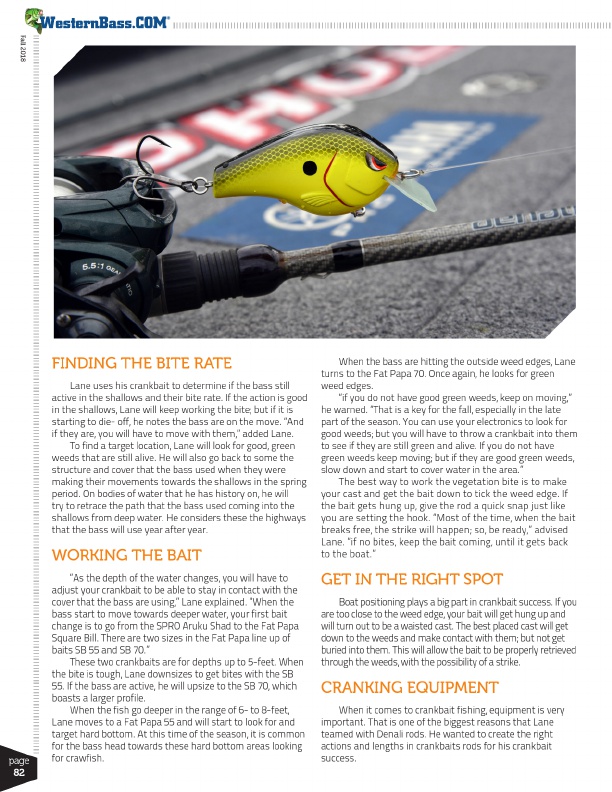
®
Fall 2018
page 82
FINDING THE BITE RATE
Lane uses his crankbait to determine if the bass still active in the shallows and their bite rate. If the action is good in the shallows, Lane will keep working the bite; but if it is starting to die- off, he notes the bass are on the move. “And if they are, you will have to move with them,” added Lane.
To find a target location, Lane will look for good, green weeds that are still alive. He will also go back to some the structure and cover that the bass used when they were making their movements towards the shallows in the spring period. On bodies of water that he has history on, he will try to retrace the path that the bass used coming into the shallows from deep water. He considers these the highways that the bass will use year after year.
WORKING THE BAIT
“As the depth of the water changes, you will have to adjust your crankbait to be able to stay in contact with the cover that the bass are using,” Lane explained. “When the bass start to move towards deeper water, your first bait change is to go from the SPRO Aruku Shad to the Fat Papa Square Bill. There are two sizes in the Fat Papa line up of baits SB 55 and SB 70.”
These two crankbaits are for depths up to 5-feet. When the bite is tough, Lane downsizes to get bites with the SB 55. If the bass are active, he will upsize to the SB 70, which boasts a larger profile.
When the fish go deeper in the range of 6- to 8-feet, Lane moves to a Fat Papa 55 and will start to look for and target hard bottom. At this time of the season, it is common for the bass head towards these hard bottom areas looking for crawfish.
When the bass are hitting the outside weed edges, Lane turns to the Fat Papa 70. Once again, he looks for green weed edges.
“if you do not have good green weeds, keep on moving,” he warned. “That is a key for the fall, especially in the late part of the season. You can use your electronics to look for good weeds; but you will have to throw a crankbait into them to see if they are still green and alive. If you do not have green weeds keep moving; but if they are good green weeds, slow down and start to cover water in the area.”
The best way to work the vegetation bite is to make your cast and get the bait down to tick the weed edge. If the bait gets hung up, give the rod a quick snap just like you are setting the hook. “Most of the time, when the bait breaks free, the strike will happen; so, be ready,” advised Lane. “if no bites, keep the bait coming, until it gets back to the boat.”
GET IN THE RIGHT SPOT
Boat positioning plays a big part in crankbait success. If you are too close to the weed edge, your bait will get hung up and will turn out to be a waisted cast. The best placed cast will get down to the weeds and make contact with them; but not get buried into them. This will allow the bait to be properly retrieved through the weeds, with the possibility of a strike.
CRANKING EQUIPMENT
When it comes to crankbait fishing, equipment is very important. That is one of the biggest reasons that Lane teamed with Denali rods. He wanted to create the right actions and lengths in crankbaits rods for his crankbait success.